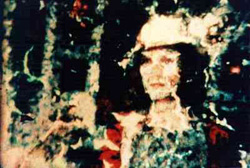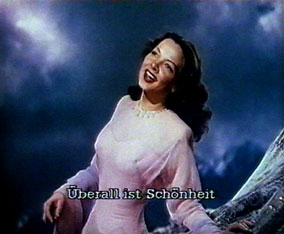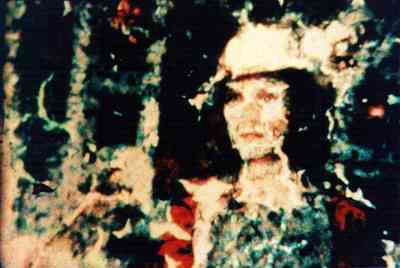Part of Fall 1990
Presented in co-operation with the Goethe Institute of Toronto
The German super-8 collective Alte Kinder (which means ‘old kids’) have changed many people’s minds about what super-8 is capable of. Using simple methods like reshooting directly off the screen and hand processing film ‘spaghetti style’ (loose, without reels) they have made works as technically intricate and lush as any 16mm productions. Their work ranges from the use of genres, such as the travelogue, to addressing issues like AIDS.
The two women and two men who make up Alte Kinder – Maija-Lene Rettig, Christiane Heuwinkel, Thomas Lauks and Matthias Muller – have been collaborating on producing, distributing and exhibiting their own and other German super-8 work since 1985. In contrast to the North American tradition of Super-8 as a rough and ready form, much of recent German Super-8 practice has produced handcrafted films that are very deliberate and technically precise. Alte Kinder, along with the Bonn-based collective Schmelz Dahin, has been at the forefront of this trend. In the last couple of years, Alte Kinder has also started to experiment with crossing Super-8 and other media and formats, including reshooting the triple-screen S8 piece The Flamethrowers on 16mm and 35mm. Tonight’s program will be presented in person by member Matthias Muller and is a sample of current work by both Alte Kinder and the films from their extensive distribution collection. Muller’s newest film about AIDS and sexuality, The Memo Book, is among the selection.
Take Courage – M. Rettig, 9 min, 1986.
Take Courage follows a diary mode tradition juxtaposing a woman’s public and private life as she explores her identity in a foreign city. Take Courage “has to do with the theme of polarity, inside and out.”
Triptychon – Studie Fuer Selbstbild – T. Mank, 11 min, 1987.
“This film creates an autoerotic dialogue with the body. The images are ephemeral, incarnating the body in an unfixed, fluid way that connects individual identity to states of change (movement, growth, aging) rather than to stasis.” (Willi Karow, Journal Film)
Aus Der Ferne – The Memo Book – M. Muller, 28 min, 1989.
The Memo Book is a meditation on the death of a friend by AIDS. “A man on a journey. Bright spots of sunlight in empty rooms. A male body on a white bedspread, curtains moving slowly in the wind, waves breaking at the shore. It is early in the morning. Someone is washing his hands, wetting his hair… What began as a tribute to a dead friend, turned out as a journey into the filmmaker’s own identity and the sensuality of the male body.” (Sebastian Grober, Szene)
The Flamethrowers – Alte Kinder, O. O’Toole & Schmelz Dahin, 9 min, 1989.
The Flamethrowers is a collaborative effort by Alte Kinder, Owen O’Toole (who presented The Almanac Project with Pleasure Dome this past summer) and Schmelz Dahin (Melt Away), A.K.’s Bonn-based contemporaries (comprised of Jochen Lempert, Jurgen Reble and Jochen Muller). “The Flamethrowers is the result of an artistic relay race, a game of associations….” (Karin Waldschmidt, Bielefelder Statblatt)
Stadt im Flammen (City in Flames) – Schmelz Dahin, 7 min, 1985.
A B-movie was buried in the ground for half a year then dug up and rephotographed and reworked to produce what is now Stadt im Flammen. Eaten away by bacteria, these Hollywood actions scenes and catastrophes suffer their own demise under the hot lens of an optical printer until they literally burn away. “Stadt im Flammen is the most volcanic film I’ve ever seen; the emulsion literally crawls off the film base, like lava flowing across terrain.” (O. O’Toole, The Independent Eye)
Epilog – M. Muller and C. Heuwinkel, 16 min, 1986¡©87.
A complex interweaving of images and sound that attempt to make the absent present. A stark meditation on loss and departure. “Superimposition/decomposition of eroded images. Their cannibalism is advanced (by burning frames) and at the same time retarded (by inserting movie leaders). Counter-rotating movements accelerate the decomposition of the original material on different levels. Original and reproduction fuse, beginning and end come together. An archaeology with the camera.”


